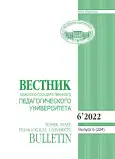Introduction. The article analyses English translations of Anton Chekhov’s The Steppe (1888), the first major work of the writer’s mature period. The central spatial landmark in the story is the steppe, whose image is of great importance for translation studies in terms of the dialectics between the national and the universal.Aim. The author aims at studying the multiple representations of the steppe in English translations in two interrelated aspects: as a nationally marked geographical space and as a “mood landscape.”Material and methods. Six English translations of The Steppe at the various stages of reception: by Adeline Kaye (1915), Constance Garnett (1919), Ronald Hingley (1980), Alex Miller (1989), Ronald Wilkes (2001), Richard Pevear and Larissa Volokhonsky (2004). The author employs a comparative approach for analysing the recurring meaningful elements (motifs) embedded in the image of the steppe (“prostor”, “dal’”, “toska”, “odinochestvo”).Results and discussion. The main spatial feature of the steppe is its infinity expressed through the motifs of “prostor” and “dal’”, which are peculiar for the perception of the steppe by native Russian speakers. The motif of “prostor” is central for Chekov’s interpretation of the steppe. “Prostor” is something that deprives people of reference points and becomes disproportionate to human aspirations. This concept most clearly manifests an indissoluble connection of the steppe infinity with the national mentality. The analysis of its English translations shows two simultaneous tendencies: while in some cases the translators specify universal components of spatial semantics (“space”, “room”), in others they seek to convey the specific properties of the Russian “prostor” through such equivalents as “spaciousness”, “wide (vast) expanse”, and “vastness.” The Russian “dal’” is mainly translated into English as “distance”. However, there is an obvious difference between “distance” and the original “dal’”: the former is more about length and directed motion, while the latter correlates with the latitude of space. The most frequent translation equivalents of “dal’” are the lexemes with the semantics of boundary (“end”, “horizon”, “limits”).The image of the steppe in Chekhov’s story demonstrates a close connection of the landscape with the characters’ state of mind. The steppe acts as a projection of people’s inner world, with its infinite vastness and endless monotony evoking all-encompassing melancholy and loneliness. These feelings become the key motifs in the image of the steppe as a “mood landscape.” Nationally and culturally determined, the motif of “toska” does not have a universal translation, producing a broad range of equivalents that shape new semantic fields for English-speaking readership. The most foregrounded concepts of grief and suffering (“to grieve”/“grief”, “misery”/“miserable”/“miserably”, “anguish” etc.) are followed by those of longing for something (“longing”, “yearning”/“yearn”), i.e. the translations primarily promote universal emotional associations. In Hingley’s translation, however, the original motif acquires a unique rendition, since the translator explicitly links melancholy with death. Similar transformations can be found in translation of the motif of loneliness. The translators mainly choose equivalents to match the emotional colouring of the original (“lonely”/“loneliness”, “solitary”/“solitariness”, “solitude”).Conclusion. Chekhov’s image of the steppe demonstrates an inextricable link between the Russian national and the writer’s pictures of the world. Since the motifs constructing the image of the steppe are deeply embedded in the national culture, their translatability into other language mentalities is limited. Various equivalents are used to adapt the image of the steppe for other cultural contexts. As a rule, the translators foreground the universal component and reduce the national specificity, adding individual accents in their renditions. At the same time, due to such an obviously inevitable cultural adaptation, the “resonance” principle of constructing the text of the story, implemented by Chekhov through the system of repetitions, was not preserved in the considered translations.
 7-16
7-16


 17-25
17-25


 26-33
26-33


 34-44
34-44


 45-51
45-51


 52-61
52-61


 62-71
62-71


 72-79
72-79


 80-87
80-87


 88-96
88-96


 97-107
97-107


 108-120
108-120


 121-131
121-131


 132-144
132-144


 145-155
145-155


 156-160
156-160


 161-165
161-165








